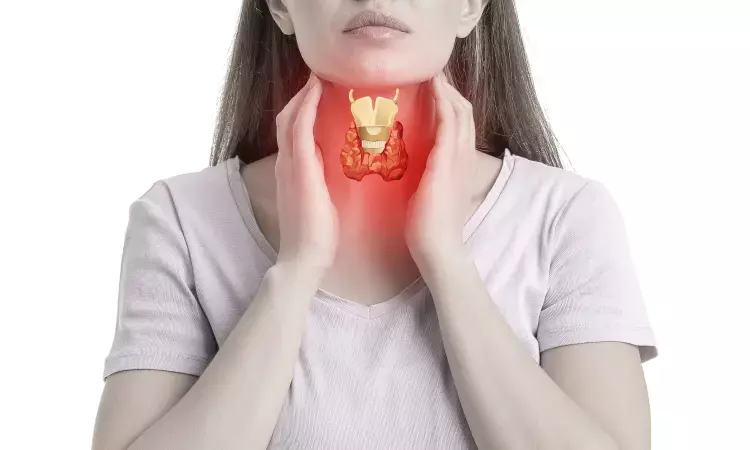- Home
- Medical news & Guidelines
- Anesthesiology
- Cardiology and CTVS
- Critical Care
- Dentistry
- Dermatology
- Diabetes and Endocrinology
- ENT
- Gastroenterology
- Medicine
- Nephrology
- Neurology
- Obstretics-Gynaecology
- Oncology
- Ophthalmology
- Orthopaedics
- Pediatrics-Neonatology
- Psychiatry
- Pulmonology
- Radiology
- Surgery
- Urology
- Laboratory Medicine
- Diet
- Nursing
- Paramedical
- Physiotherapy
- Health news
- Fact Check
- Bone Health Fact Check
- Brain Health Fact Check
- Cancer Related Fact Check
- Child Care Fact Check
- Dental and oral health fact check
- Diabetes and metabolic health fact check
- Diet and Nutrition Fact Check
- Eye and ENT Care Fact Check
- Fitness fact check
- Gut health fact check
- Heart health fact check
- Kidney health fact check
- Medical education fact check
- Men's health fact check
- Respiratory fact check
- Skin and hair care fact check
- Vaccine and Immunization fact check
- Women's health fact check
- AYUSH
- State News
- Andaman and Nicobar Islands
- Andhra Pradesh
- Arunachal Pradesh
- Assam
- Bihar
- Chandigarh
- Chattisgarh
- Dadra and Nagar Haveli
- Daman and Diu
- Delhi
- Goa
- Gujarat
- Haryana
- Himachal Pradesh
- Jammu & Kashmir
- Jharkhand
- Karnataka
- Kerala
- Ladakh
- Lakshadweep
- Madhya Pradesh
- Maharashtra
- Manipur
- Meghalaya
- Mizoram
- Nagaland
- Odisha
- Puducherry
- Punjab
- Rajasthan
- Sikkim
- Tamil Nadu
- Telangana
- Tripura
- Uttar Pradesh
- Uttrakhand
- West Bengal
- Medical Education
- Industry
Fiber-based NIRAF enhances parathyroid gland detection during endocrine neck surgery and may help reduce complications: JAMA

A new study published in the Journal of American Medical Association showed that during endocrine neck surgery, fiber-based near-infrared autofluorescence (NIRAF) improves parathyroid gland identification and might potentially lower complications.
Accurately identifying and protecting parathyroid glands (PGs) during parathyroidectomy and thyroidectomy is essential since their removal or injury can result in hypoparathyroidism. Thus, this study determined if fiber-based NIRAF lowers the incidence of hypoparathyroidism and enhances the number of PGs discovered intraoperatively.
From March 2020 to July 2024, this clinical study with a 6-month follow-up was carried out. It comprised 3 junior (less than 5 years of experience) and four senior (more than 10 years of experience) surgeons from 4 medical centers across the US. A total of 398 individuals (2 withdrew) got parathyroidectomy, and 354 patients had total/completion thyroidectomy, out of the 754 patients who were recruited and 752 who were randomized. The use of fiber-based NIRAF during thyroid and parathyroidectomy was one of the primary therapies.
The primary outcome (94.4%) was examined for 712 out of 752 randomly assigned individuals. In all, 159 patients had traditional surgery, and 161 got parathyroidectomy with NIRAF. Furthermore, 178 had conventional surgery, and 176 had thyroidectomies utilizing NIRAF.
Using NIRAF for targeted operations did not substantially increase the mean number of PGs found during parathyroidectomy (mean, NIRAF, 1.6; 95% CI, 1.4-1.8 vs. control, 1.5; 95% CI, 1.4-1.7). The mean number of PGs found by the surgeons utilizing NIRAF during bilateral explorations was higher (mean NIRAF, 3.5; 95% CI, 3.4-3.7 vs. control, 3.2; 95% CI, 3.0-3.4; P <.001).
The mean number of PGs detected during thyroidectomy was higher when NIRAF was used (mean NIRAF, 3.3; 95% CI, 3.2-3.4 versus control, 2.8; 95% CI, 2.7-3.0; P <.001). Hypoparathyroidism following thyroidectomy did not significantly vary at the last follow-up (NIRAF: 3 of 176 patients [1.7%]; control: 6 of 176 patients [3.4%]) or during the transitory period (NIRAF: 48 of 173 patients [27.8%]; control: 44 of 169 patients [26%]).
Overall, this study suggest fiber-based NIRAF, may assist surgeons in confidently identifying more PGs during bilateral exploration, but it offers no further benefit during targeted surgeries. Regardless of the method, the number of PGs found increased during thyroidectomy. Even while NIRAF had no discernible effect on short-term patient outcomes, surgeons may find it useful as an intraoperative tool in situations where alternative techniques for PG tissue confirmation are not accessible.
Source:
Cousart, A. G., Kiernan, C. M., Willmon, P. A., Thomas, G., Wang, T. S., Gauger, P. G., Duh, Q.-Y., Underwood, H. J., Jackson, A., Patel, A., Mahadevan-Jansen, A., & Solórzano, C. C. (2025). Near-infrared autofluorescence for parathyroid detection during endocrine neck surgery: A randomized clinical trial: A randomized clinical trial. JAMA Surgery. https://doi.org/10.1001/jamasurg.2025.2233
Neuroscience Masters graduate
Jacinthlyn Sylvia, a Neuroscience Master's graduate from Chennai has worked extensively in deciphering the neurobiology of cognition and motor control in aging. She also has spread-out exposure to Neurosurgery from her Bachelor’s. She is currently involved in active Neuro-Oncology research. She is an upcoming neuroscientist with a fiery passion for writing. Her news cover at Medical Dialogues feature recent discoveries and updates from the healthcare and biomedical research fields. She can be reached at editorial@medicaldialogues.in
Dr Kamal Kant Kohli-MBBS, DTCD- a chest specialist with more than 30 years of practice and a flair for writing clinical articles, Dr Kamal Kant Kohli joined Medical Dialogues as a Chief Editor of Medical News. Besides writing articles, as an editor, he proofreads and verifies all the medical content published on Medical Dialogues including those coming from journals, studies,medical conferences,guidelines etc. Email: drkohli@medicaldialogues.in. Contact no. 011-43720751


